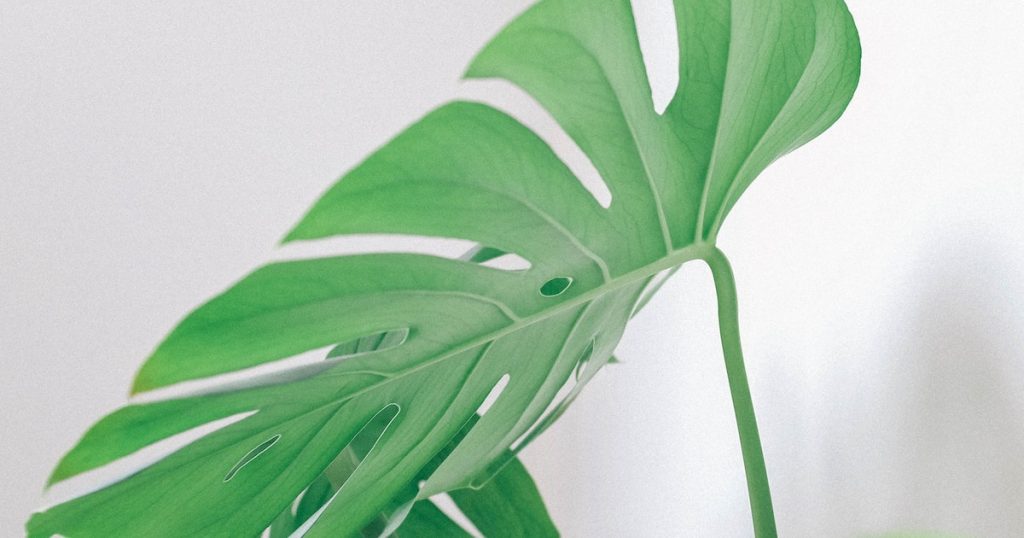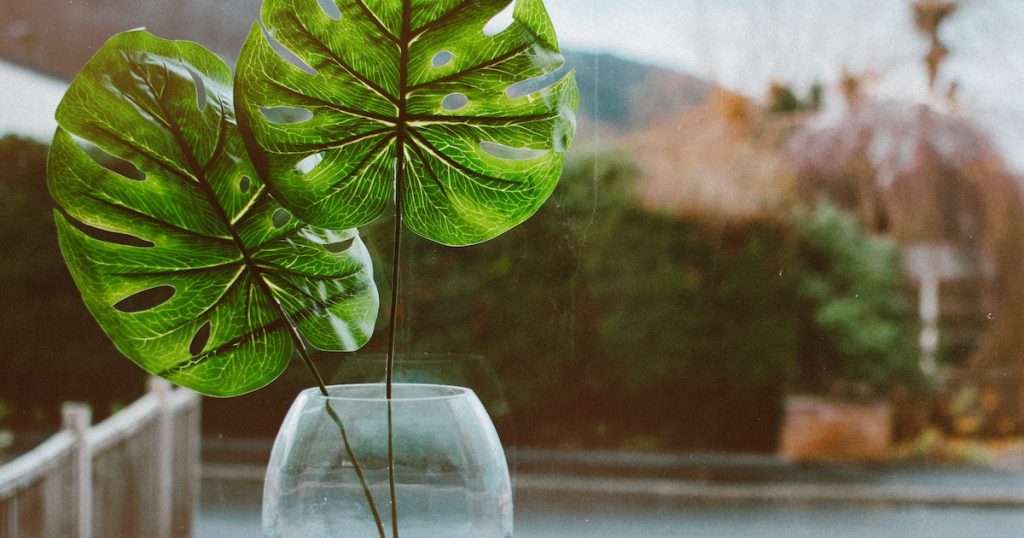Have you ever had a Monstera deliciosa, also known as Swiss Cheese Plant or Split-Leaf Philodendron, and noticed the leaves have fascinating splits in them? If so, there’s no need to worry about your plant! So the question is, why do Monstera leaves split in the first place?
There are many scientific theories about why Monstera leaves split. Some think it is a function to increase surface area, while others suggest it allows light to reach the plant’s lower leaves or even to provide resistance to damage by strong winds.
This blog post will explore what causes Monstera leaves to split and the science behind it so you can better understand this unique behavior. Read on to learn more about the Monstera plant and some of the issues it can face on the leaf-splitting front.

Table of Contents
An Introduction To The Monstera Plant
An iconic symbol of a tropical paradise, Monstera is the perfect addition to any indoor or outdoor garden.
While these plants generally appreciate warm and humid conditions like their native Central and South America home, these plants are surprisingly hardy and easy to care for – making them ideal even for novice horticulturists!
Instead, the Monstera can be grown indoors in ideal conditions, and enthusiasts can even grow them outside if they live in tropical or even semi-tropical areas.
What really sets them apart from other house plants though, has got to be those signature large holes in their leaves – recognizable around the world as an instantly identifiable part of this beautiful plant’s personality.
What Are The Holes In Monstera Leaves Called?
Monstera leaves are uniquely decorated with mysterious holes, known as fenestrations. These patterns provide a stunning contrast to their lush landscapes of large green foliage.
For decades, Monstera owners have marveled at the unique phenomenon of fenestration: holes and splits in the foliage which form naturally.
These holes and spaces in Monstera leaves are much sought after by plant enthusiasts – a beautiful sign that your Monstera is growing perfectly!
Without the unique, Instagram-worthy splits of a Monstera plant’s leaves, it can be tough to tell whether your beloved greenery is healthy or not.
While solid green foliage may look beautiful, if you want to keep your Monstera looking and feeling its best, make sure those natural fenestrations appear!

Why Monstera Leaves Split
There are many theories out there about why Monstera leaves create fenestrations. In fact, for a long time, this has been a mystery in its own right.
As of today, we still don’t have an exact answer as to why this splitting happens, especially as other local plants don’t show the same adaptation to their environment. However, there are plenty of theories on why, with each having a lot of evidence to support their claim.
One of the most common theories to explain the presence of holes in Monstera leaves is that they allow the leaf to absorb more water and sunlight by increasing the surface area without an added need to grow more leaves.
Because Monstera is a relatively shorter plant compared to the huge trees it grows next to, it can use all the sunlight and water it can get to grow properly.
Many believe that plants can remain at their normal size due to an innate adaptation – holes forming on larger leaves, which enable the light from above to reach the lower parts of a plant still.
In effect, this allows growth even in shady areas and keeps all sections of the plant consistent without sacrificing any vital access to sunlight.
According to some other enthusiasts, fenestrations exist to help remove the surface tension of strong winds, which helps the plant survive storms.
Another theory is that the fenestration holes make for a great draining system, preventing water from collecting on the leaf and causing dangerous consequences such as plant rot.
There’s even a theory that this is an adaptation of mimicry designed to let insects think that the plant has already been attacked.
No matter what the cause is, we know that healthy Monstera leaves need these fenestrations to survive.
The distinctive split-leaf pattern of Monstera plants is a hallmark sign that they thrive in environments similar to their native habitat. To ensure your own plant’s health, you should replicate this environment as best as possible!
Here is a video giving tips on getting clear fenestrations on Monstera leaves:
At What Stage Does A Monstera Leaf Split?
A common question that first-time Monstera owners wonder about is when the leaf should start splitting in a Monstera’s lifespan.
The answer primarily lies in the age of the plant, as that is what will determine when the fenestrations start showing up on the plant’s leaf. In fact, most Monsteras only begin to show this pattern a few years later.
When the plant is younger, its leaves are smaller and completely solid. As it grows more and more, the size of the leaf increases, and around the 2-3 year mark, the splitting will start.
In some Monsteras, this can happen as early as one year, but it is more likely for this process to take some more time and peak after a couple of years of growth.
Once this time has passed, a healthy Monstera plant will develop splits, given that it is growing under the right environmental conditions.
Growing Monstera inside the house happens when it has a lot of space to grow or when the plant itself has gotten old enough. However, in some cases, issues can cause the splitting to stall.
Problems That Can Impact The Monstera’s Ability To Split
As mentioned in the last section, Monstera’s growth relies on several factors. If your Monstera has not split even after a few years of growth, it may be time to look into common problems. Once you identify the issue at hand, you can work to solve the problem and restore your indoor Monstera’s ability to grow.

The Age Of The Plant
You may have noticed that age has much to do with whether or not a Monstera leaf splits.
One common thing that happens is people unfamiliar with the plant may assume it starts showing signs of fenestration from the first leaf. However, the only leaves you see will be like a typical solid leaf in the first few years of your plant’s life.
With a little bit of patience, you will find that the leaves will change after some time. The only time you should start feeling concerned is when your Monstera is past the age of three years and there are still no signs of fenestration.
If that is the case, keep moving through the sections in this article to find out what could be the problem at hand and how to solve it.
Lack Of Access To Sunlight
As with any other plant, Monsters need adequate access to sunlight to grow in a healthy way. So, it makes sense that impaired access to this resource can slow down the creation of fenestration on the Monstera leaf.
This becomes an even more plausible factor when you consider the reasons for fenestration that we discussed in the section above.
In order to grow to their full potential, Monsteras will need to have healthy access to light, which is bright but indirect.
Some of the plants may be able to handle moderate amounts of light, but there is no situation where your Monstera can grow in dim lighting. Even if the plant survives, it will not be healthy enough to create the leaf patterns you are eager to see.
Because of the low levels of light, there are slower rates of photosynthesis, and as a result, the growth of the plant becomes much smaller. One of the easiest ways to see this is if one side of the plant has better light access.
The leaves near the light will be bigger and split, whereas the others can be much smaller. The best way to take care of this problem is to move your Monstera so it is close to the light (however, keep it out of direct light).
You should also give the plant a chance to enjoy the gentle light of the sun directly in the morning, as a way to improve the current status of the leaves.
Too Little Water
Just like plants need sunlight to grow, they also need access to clean and beneficial water sources to thrive.
One of the ways that your plant can suffer is if there is no adequate access to water. This is because water is just as necessary for the plant to be able to carry out photosynthesis, without which it will not be able to grow.
This is especially true for Monstera plants, which are moisture lovers by nature. These plants enjoy a humid environment and moist soil, to mimic the environment of their tropical origins.
If your Monstera is consistently not watered enough, its growth will be severely affected, and you may see other effects than just a lack of splitting, such as browning of leaves.
To ensure this is a fate your Monstera can be spared from, always water the Monstera regularly according to their preferred water schedule.
Check the soil to indicate how much water the plant needs, and make sure to use soil and pots that drain well for this purpose. Not only can this promote splitting, but it will keep your Monstera healthy too.

Not Enough Nutrients
The last ingredient in the recipe for photosynthesis, and many other plant functions is the presence and availability of nutrients.
Plants take up nutrients through their root systems, and use them throughout the plant for various functions, with the eventual target of growth. Without these nutrients, they will either grow slowly or stop growing at all.
The Monstera cannot create splitting leaves without a healthy nutrient balance. The plant needs nutrients to sustain itself in different ways.
Since most indoor plants are grown in pots, you need to ensure the right balance is provided artificially, unlike plants growing in wild forests, which can access it because of the constant life cycle and access to larger soil areas.
Therefore, indoor Monstera plants will need to be given some sort of fertilizer to provide the optimal environment for growth.
You can come up with an adequate fertilizing routine by discussing the needs of your Monstera plant with a gardening expert, or from tutorials online. The best routine is to use fertilizer around once a month, although your schedule may vary.
Small Plant Pots
Finally, one factor many owners may not consider is the space they offer their plants to grow. Monsteras are large plants and thrive when they can create large root systems.
This is because this plant grows fast, and they are likely to fill out the pots sooner than you’d think. As a result, roots can start curling and even enter draining holes.
This is a sure sign that the plant is not getting enough space to grow, and when this happens, you will be unlikely to see fenestration on the leaves. This is because the plant may stop growing altogether, and even halt the process of growing new leaves.
Obviously, this is not an outcome anyone wants, so it is important to keep an eye on the root sizes of your Monstera. A good approach is to move the Monstera to a pot that is at least two sizes bigger, and use better soil that can drain faster, to avoid chances of rotting.
While it may take some time, this is likely to bring your plant back to life. And if you’re getting a new Monstera, make sure you get a large pot that is right for its root system.
Final Thoughts
Split Monstera leaves are one of nature’s most beautiful sights, and now you know why this happens! There are a number of factors that can affect the ability of your Monstera plant to grow fenestration leaves.
From watering to pot space, there are various approaches you can take to promote healthy growth for this plant in particular. With the right care and attention, you will be able to enjoy watching your Monstera split leaves with ease.
Recent Posts
Have you found yourself wondering, 'why is my bamboo growing so slow?' Despite the fact that bamboo plants are remarkably fast-growing, it can sometimes take months (or even years!) to see any signs...
Miracle-Gro is a huge help when you are trying to get decent yields out of your plants or if you want them to thrive. However, you may have noticed that a single dose of fertilizer does little to...
